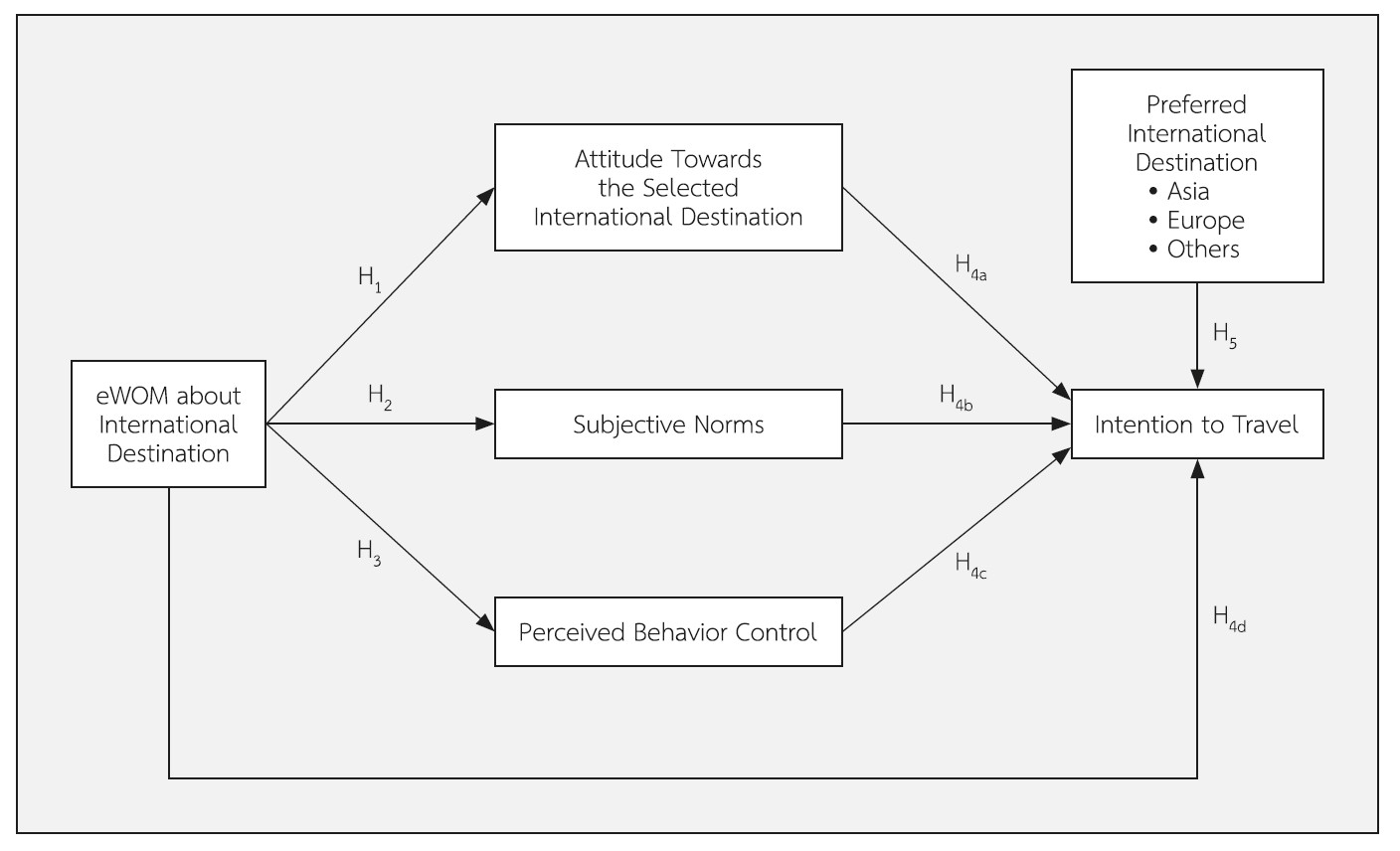The eWOM Effect Towards Travel Destination Decision-Making Process
Keywords:
Electronic Word of Mouth, eWOM, Tourism, Theory of Planned BehaviourAbstract
This research aimed to investigate the influence of electronic word-of-mouth (eWOM) on chosen travel destinations through theory of planned behavior (TPB) as well as explore the relationship between destination preference and intention to travel. The research was carried out using non-probability, quota, convenience sampling method, and snowball technique. Data collected was analyzed by simple linear regression (SLR), multiple linear regression (MLR), analysis of covariance structures and analysis of variance (ANOVA) to investigate the relationship, impact, and differences. The total of 414 respondents were Bangkok residents who had experience travelling outside Thailand. Results found that eWOM, attitude towards the selected international destination, subjective norms, and perceived behavioural control had significant impacts towards intention to travel; and each selected destination had a different effect on intention to travel.
References
Anderson, C.K. (2012), “The impact of social media on lodging performance”, Cornell Hospitality Report, Vol. 12 No. 15, pp. 4-11.
Ajzen, I. (1991), “The theory of planned behaviour”, Organizational Behaviour and Human Decision Process, Vol. 50 No. 2, pp. 179-211.
Ajzen, I. (2011), The Theory of Planned Behaviour: reactions and Reflections, Taylor&Francis.
Ajzen, I. and Fishbein, M. (1980), Understanding Attitudes and Predicting Social Behaviour, Prentice-Hall, Englewood Cliffs, NJ.
Bandura, A. (1982), “Self-efficacy mechanism in human agency”, American Psychologist, Vol. 37 No. 2, pp. 122-47.
Bansal, H.S. and Voyer, P.A. (2000), “Word-of-mouth processes within a services purchase decision context”, Journal of Service Research, Vol. 3 No. 2, pp. 166-177.
Cho, I., Park, H. and Kim, K. (2015), “The relationship between motivation and information sharing about products and services on Facebook”, Behaviour & Information Technology, Vol. 34 No. 9, pp. 858-868.
Cleveland, M. and Laroche, M. (2007), “Acculturation to the global consumer culture: scale development and research paradigm”, Journal of Business Research, Vol. 60 No. 3, pp. 249-59.
Cochran, W. G. (1977), Sampling techniques (3rd ed.). New York: John Wiley & Sons.
Dossey, B.M. and Keegan, L. (2008), Holistic Nursing: A Handbook for Practice, Jones and Bartlett Learning, Sadbury, MA.
Flannery, B.L. and May, D.R. (2000), “Environmental ethical decision making in the US metal-finishing industry”, Academy of Management Journal, Vol. 43 No. 4, pp. 642-62.
Gallarza, M.G., Arteaga, F., Floristán, E. and Gil, I. (2009), “Consumer behavior in a religious event experience: an empirical assessment of value dimensionality among volunteers”, International Journal of Culture, Tourism And Hospitality Research, Vol. 3 No. 2, pp. 165-180.
Giantari, G.A.K., Zain, D., Rahayu, M. and Solimun. (2013), “The role of perceived behavioral control and trust as mediator of experience on online purchasing intentions relationship a study on youths in Denpasar city (Indonesia)”, International Journal of Business and Management Invention, Vol. 2 No. 1, pp. 30-38.
Hennig-Thurau, T., Gwinner, K.P., Walsh, G. and Gremler, D.D. (2004), “Electronic word-of-mouth via consumer‐opinion platforms: what motivates consumers to articulate themselves on the internet?”, Journal of Interactive Marketing, Vol. 18 No. 1, pp. 38-52.
Hoyer, W.D. and Maclnis, D.J. (2004), Consumer Behavior, Houghton Mifflin, Boston, MA.
Hsu, C.-L. and Lu, H.-P. (2004), “Why do people play online games? An extended TAM with social influences and flow experience”, Information and Management, Vol. 41 No. 7, pp. 853-68.
Hutchinson, D., Wellington, W.J., Saad, M. and Cox, P. (2011), “Refining value-based differentiation in business relationships: a study of the higher order relationship building blocks that influence behavioural intentions”, Industrial Marketing Management, Vol. 40 No. 3, pp. 465-478.
Internet Advertising Bureau (2008), “User generated content, social media, and advertising: an overview”, Internet Advertising Bureau, London, Internet Advertising Bureau Status Report, April.
Jung, C.G. (1971), Psychological Types, Collected Works, Vol. 6, Princeton University Press, Princeton, NJ.
Kassem, N.O., Lee, J.W., Modeste, N.N. and Johnston, P.K. (2010), “Understanding soft drink consumption among female adolescents using the theory of planned behavior”, Health Education Research, Vol. 18 No. 3, pp. 278-91.
Kraus, S.J. (1995), “Attitudes and the prediction of behavior: a meta-analysis of the empirical literature”, Personality and Social Psychology Bulletin, Vol. 21 No. 1, pp. 58-75.
Lam, T. and Hsu, C.H. (2004), “Theory of planned behavior: potential travelers from China”, Journal of Hospitality& Tourism Research, Vol. 28 No. 4, pp. 463-482.
Lam, T. and Hsu, C.H. (2006), “Predicting behavioral intention of choosing a travel destination”, Tourism Management, Vol. 27 No. 4, pp. 589-599.
Lin, H. (2006), “Understanding behavioral intention to participate in virtual communities”, Cyberpsychology & Behavior, Vol. 9 No. 5, pp. 540-547.
Litvin, S.W., Goldsmith, R.E. and Pan, B. (2008), “Electronic word-of-mouth in hospitality and tourism management”, Tourism Management, Vol. 29 No. 3, pp. 458-468.
Lopez-Nicolas, C., Molina-Castillo, F.J. and Bouwman, H. (2008), “An assessment of advanced mobile services acceptance: contributions from TAM and diffusion theory models”, Information and Management, Vol. 45 No. 6, pp. 359-64.
Martin, D.S., Ramamonjiarivelo, Z. and Martin, W.S. (2011), “MEDTOUR: a scale for measuring medical tourism intentions”, Tourism Review, Vol. 66 Nos 1/2, pp. 45-56.
Mathieson, K. (1991), “Predicting user intentions: comparing the technology acceptance model with the theory of planned behavior”, Information Systems Research, Vol. 2 No. 3, pp. 173-91.
Ministry of Tourism & Sports. (n.d.), Retrieved March 25, 2019 from Ministry of Tourism & Sports website: https://www.mots.go.th/more_news.php?cid=411&filename=index.
Mukaka M. M. (2012), Statistics corner: A guide to appropriate use of correlation coefficient in medical research. Malawi medical journal : the journal of Medical Association of Malawi, 24(3), 69–71.
Nunnally, J. C. (1978), Psychometric theory. New York: McGraw-Hill.
Pavlou, P.A. and Fygenson, M. (2006), “Understanding and predicting electronic commerce adoption: an extension of the theory of planned behavior”, MIS Quarterly, Vol. 30 No. 1, pp. 115-43.
Phelps, J., Lewis, R., Mobilio, L., Perry, D. and Raman, N. (2004), “Viral marketing or electronic word‐of‐mouth advertising: examining consumer responses and motivations to pass along e‐mail”, Journal of Advertising Research, Vol. 44 No. 4, pp. 333‐48.
Quinlan, S., Jaccard, J. and Blanton, H. (2006), “A decision theoretic and prototype conceptualisation of possible selves: implications for the prediction of risk behaviour”, Journal of Personality, Vol. 74 No. 2, pp. 599-630.
Silverman, G. (2001), The Secrets of Word-of-Mouth Marketing: How to Trigger Exponential Sales Through Runaway Word-of-Mouth, Amacom Books, New York, NY.
Smith, R.E. and Vogt, C.A. (1995), “The effects of integrating advertising and negative word-of-mouth communications on message processing and response”, Journal of Consumer Psychology, Vol. 4 No. 2, pp. 133-51.
Soderlund, M. and Rosengren, S. (2007), “Receiving word-of-mouth from the service customer: an emotion-based effectiveness assessment”, Journal of Retailing and Consumer Services, Vol. 14 No. 2, pp. 123-36.
Statista Research Department. (2019), Retrieved December 25, 2019 from Statista website: https://www.statista.com/statistics/284483/thailand-social-network-penetration/
Sun, T., Youn, S., Wu, G. and Kuntaraporn, M. (2006), “Online word-of-mouth (or mouse): an exploration of its antecedents and consequences”, Journal of Computer-Mediated Communication, Vol. 11 No. 4, pp. 1104-1127.
Truong, V. (2014), “Social marketing a systematic review of research 1998-2012”, Social Marketing Quarterly, Vol. 20 No. 1, pp. 15-34.
van Dam, K., van der Vorst, J.D.M. and van der Heijden, B.I.J.M. (2009), “Employees’ intentions to retire early: a case of planned behavior and anticipated work conditions”, Journal of Career Development, Vol. 35 No. 3, pp. 265-289.
Venkatesh, V. and Davis, F.D. (2000), “A theoretical extension of the technology acceptance model: four longitudinal field studies”, Management Science, Vol. 46 No. 2, pp. 186-204.
Vermeulen, I.E. and Seegers, D. (2009), “Tried and tested: the impact of online hotel reviews on consumer consideration”, Tourism Management, Vol. 30 No. 1, pp. 123-7.
Westbrook, R.A. (1987), “Product/consumption based affective responses and postpurchase processes”, Journal of Marketing Research, Vol. 24 No. 3, pp. 258‐70.
Yacouel, N. and Fleischer, A. (2012), “The role of cybermediaries in reputation building and price premiums in the online hotel market”, Journal of Travel Research, Vol. 51 No. 2, pp. 219-226.
Ying, H.L. and Chung, C.M.Y. (2007), “The effects of single-message single-source mixed word-of-mouth on product attitude and purchase intention”, Asia Pacific Journal of Marketing, Vol. 19 No. 1, pp. 75-86.
Yoon, Y. and Uysal, M. (2005), “An examination of the effects of motivation and satisfaction on destination loyalty: a structural model”, Tourism Management, Vol. 26 No. 1, pp. 45-56.
Zeithaml, V., Berry, L.L. and Parasuraman, A. (1996), “The behavioral consequences of service quality”, Journal of Marketing, Vol. 60 No. 2, pp. 31-46.
Zhou, T. (2011), “Understanding online community user participation: a social influence perspective”, Internet Research, Vol. 21 No. 1, pp. 67-81.

Downloads
Published
How to Cite
Issue
Section
License
Copyright (c) 2022 https://creativecommons.org/licenses/by-nc-nd/4.0/

This work is licensed under a Creative Commons Attribution-NonCommercial-NoDerivatives 4.0 International License.


